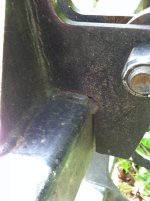IslandTractor
Super Star Member
- Joined
- Sep 15, 2005
- Messages
- 16,647
- Location
- Prudence Island, RI
- Tractor
- 2007 Kioti DK40se HST, Woods BH
That is my perspective. I plan on keeping the grapple and reinforcing it if needed, to do the job I bought it for. Welding on some extra steel while everything is straight and true is a much easier prospect than repairing one that is already wrecked. I'd like to see them make an improvement to the product by upgrading to 1/4" steel and/or improving whatever else is causing these failures and thrive in business as a result but it is unreasonable, in my opinion, to demand they redesign the product to replace mine with a new and improved model, if they have not made the improvements already. If Whirlpool comes out to repair or replace a broken dishwasher, it would be unreasonable for me to demand that they redesign the dishwasher before replacing the broken one.
I agree that is a good solution for you if you are willing and able to do the necessary modifications. However IMO, until we learn that Wildkat has actually changed to 1/4" wall top tubing, anyone contemplating a grapple purchase should steer clear unless they 1) have a very light weight machine with limited loader power. Or 2) intend to give it the Lada treatment and put some reinforcement on that top tube before ever using it. As it stands, I wouldn't put one on my old CK20.



